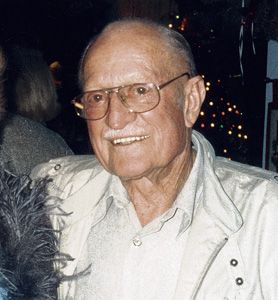 John Richard Rossi was born April19, 1915, in Placerville, Calif. He grew up in San Francisco and split hiscollege years between the University of California at Berkeley and the merchantmarine. He entered the Navy for flight training in the fall of 1939. Uponreceiving his wings and commission in 1940, he was assigned as Flight Instructorat Pensacola, Fla. Dick resigned his Navy commission in 1941 to join theAmerican Volunteer Group (AVG) under the command of Colonel Claire Chennault. Hewas undergoing a training program in P-40 aircraft at Toungoo, Burma, when PearlHarbor was attacked. Dick was a member of the AVG’s First Pursuit Squadron(nicknamed Adam and Eve in honor of the first pursuit). He also flew with theSecond and Third Squadrons, serving under all the AVG squadron commanders. TheAVG flew actual combat for seven months, logging 299 combat victories withanother probable 600 aircraft destroyed on the ground. Losses were four pilotslost in aerial combat, seven shot down and killed by anti-aircraft fire duringstrafing runs, and eight killed in operational and training accidents unrelated toenemy action. Four were MIA and three of those were found to be POWs. Three diedfrom Japanese bombing raids. One was shot down and seen alive, but no word as tohis fate. The American Fighter AcesAssociation confirms 20 AVG pilots as Aces with another six pilots achievingAce status during the next few years.
John Richard Rossi was born April19, 1915, in Placerville, Calif. He grew up in San Francisco and split hiscollege years between the University of California at Berkeley and the merchantmarine. He entered the Navy for flight training in the fall of 1939. Uponreceiving his wings and commission in 1940, he was assigned as Flight Instructorat Pensacola, Fla. Dick resigned his Navy commission in 1941 to join theAmerican Volunteer Group (AVG) under the command of Colonel Claire Chennault. Hewas undergoing a training program in P-40 aircraft at Toungoo, Burma, when PearlHarbor was attacked. Dick was a member of the AVG’s First Pursuit Squadron(nicknamed Adam and Eve in honor of the first pursuit). He also flew with theSecond and Third Squadrons, serving under all the AVG squadron commanders. TheAVG flew actual combat for seven months, logging 299 combat victories withanother probable 600 aircraft destroyed on the ground. Losses were four pilotslost in aerial combat, seven shot down and killed by anti-aircraft fire duringstrafing runs, and eight killed in operational and training accidents unrelated toenemy action. Four were MIA and three of those were found to be POWs. Three diedfrom Japanese bombing raids. One was shot down and seen alive, but no word as tohis fate. The American Fighter AcesAssociation confirms 20 AVG pilots as Aces with another six pilots achievingAce status during the next few years.
When the AVG, better known as the "Flying Tigers," was disbanded in1942, Rossi joined the China National Aviation Corporation, flying supplies fromIndia to China. By the time the war was over he had flown more than 735 tripsacross the "Hump." After the war, Rossi helped his fellow AVG Ace BobPrescott begin the Flying Tiger Line,where he flew as a Captain for 25 years, logging a lifetime of over 25,000 hoursflying. He has served as president of the American Volunteer Group Flying TigersAssociation for 50 years and is a member of the American Fighter AcesAssociation. The Chinese government awarded Rossi the White Cloud Banner (YunMo) V Grade, China Air Force Wings (Five Stars), and the China War Memorial(Kang Chan Chi-nien Chang) Decoration. He has also received two DistinguishedFlying Crosses, the Air Medal, two Presidential Unit Citations, a World War IIVictory Medal, the Asiatic Pacific Campaign Medal with four bronze stars for theIndia-Burma, Central Burma, China Defensive, and China Offensive campaigns, andthe Honorable Service Lapel Button. In 1969 he was given a Commendation from theUSAF for sustained aerial support of combat operations in South Vietnam. The AVGwas inducted into the Confederate Air Force Hall of Fame in 1998, in Midland,Tex. Dick is credited with 6.25 kills.
Where did you learn to fly?
In the mid-’30s I was in the Merchant Marine for about five years before Ijoined the Navy. I was working my way through Cal Berkeley and one of the guyswho was on the crew with us was a bug on aviation. He lived in the East Coastand had run away from home when he was 13. The ship was in Honolulu on a layoverand he talked us into going down to the airport there and taking a ride aroundthe island. All the rest of us guys would spend our money conservatively on wineand women, and he’s wasting his on flying, and, anyway, we went down and he hadkind of highway monoplane — I think it was a Fairchild but I don’t remember forsure — and we took a ride all around the island to see it from the air. When wegot back the instructor said, ‘How was the ride?’ I said, ‘It wasn’t muchdifferent than riding the bus. You just sit there and go around,’ so then hesays, ‘Well, would you like to try something a little more interesting?’ and Isaid, ‘Yes.’ He said, ‘Okay, for five bucks, we take you up,’ and they had aGreat Lakes trainer or something there, two-seated, you know, an open-aircockpit, so we went up and went through all the aerobatics and all that stuffand I said, ‘Now, that’s what I thought flying should be,’ and when we come downI really liked it. Those were the only two times I’d been on an airplane.
I worked on a ship called the President Garfield, which is the same shipChenault went out to China on. When we got out of Manila there were two Navyofficers came aboard and one of them was a captain and one of them was acommander, which, at that time, was pretty high rank in the Navy. It was beforethe war, before they branched out. I was serving drinks at the bar amongst theother duties I had so I saw a lot of these guys. I had told them about wantingto get into flying and wishing I could get in the Navy and when they left theship they each gave me a letter of recommendation. I saw a notice on thebulletin board at Cal that if you joined the Navy you could get into Pensacola,take a year’s instruction, spend three years in the fleet and at the end you’dget 1500 bucks. That looked like pretty good money at the time and so I put inmy application and I put their two letters with it.
I went over to the Navy and took the physical and I was underweight. I wasdrinking water and eating bananas and when the doc gave me the exam, he said,’Well, I don’t find anything wrong with you except you being underweight,’ andthey get something they call NCD — Not Considered Disqualified. Every exam Itook in the Navy I had to go get an NCD because I never got any more weight,but, I got the call, I went over and I passed. After we got through there myspecialty was supposed to be single-engine seaplanes, and I never flew anythingin the Navy that wasn’t a biplane except the SNJs because that’s what we tookour instrument flying in. When I got my instrument check ride I wasn’t very goodand the guy that gave me the check ride says, ‘Well, I’ll pass you if youpromise me never to fly instruments.’ That was funny because later on I ended upflying for CNAC over the hump which was instruments most of the time.
Which biplanes were you flying?
I instructed primary for a year in the N3-Ns during ’40 and into ’41. Thatyear was really pretty good training because flying two periods in the morningfor three hours, two hours off, then another three hours, five days a week, youlearn more than any other cadet did. We had a greater rate of getting our cadetsthrough because we had just been through it and I think knowing how tough it wasmaybe made us more tolerant with the cadets.
Any students stick out in your mind?
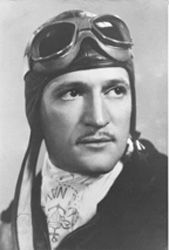 |
I had a student named Herman Rossi, and I had him as a student and I neversaw him again. I ran into him later in Arizona but he’s passed away since, buthe became an Ace. He’s in the Ace book along with the rest of us, so every timeI look up my name I see Herman Rossi first.
How did you get from Pensacola to Burma?
A retired Commander named Irvine posted a note on the base that said, ‘Meetat the San Carlos Hotel.’ They gave us a room number and we got down there,there were about 40 people there. At that time old JoeFoss was my roommate, and I tried to get him to go too, but Joe says, ‘Idecided that the Marine Corps would last longer than the AVG, so I took theMarine Corps.’
We all met at the San Carlos, and we were only supposed to be released forone year and when the end of the year was up we were supposed to go right backto where we left at our same seniority. We wouldn’t have lost anything and wefigured if we got into actual combat out there it would have been a hell of anice boost for our resume. Now everybody now I talk to says, yeah, we saw PearlHarbor coming, but I don’t think anybody really saw it coming or they would havedone something about it, except Churchill; he saw it coming, but he wouldn’ttell us.
One of the guys in the room was Lieutenant JG back from duty on the fleet,and he asks, ‘Well, when these inexperienced guys sign up, what are they goingto get in the way of pay and rank when they get out there, compared to somebodylike me, who knows it all, so to speak?’ and this guy recruiting says, ‘Have youever been fired at with live ammunition?’ and the JG says, ‘No, of course not,’and he says, ‘Well then you’ve had no experience,’ and the guy got insulted andwalked out. Out of that group 36 of us signed up.
What did they tell you you’d be doing?
We were supposed to protect the Burma Road from China in and they said we’donly be flying against bombers which would be bombing this road. At that time wethought, ‘They’re not going to be silly enough to attack something that belongsto the British Empire.’ We didn’t know what we were going to be flying. We’dnever even heard of a P-40. The P-40 was the first airplane I was ever in thathad forward firing guns. In the seaplanes we had a guy in the back with a .30caliber.
The first time I ever fired those guns on the P-40, it was a stationarytarget against a bank. Every fifth bullet was a tracer, so it was kind of liketaking a hose and you just raised it ’til you hit something. The target isn’tmoving. The second time I pulled the trigger I was in combat over Burma on theother side of the gulf from Rangoon. We were asked to escort three BritishBlenheims. Well, as we got out over the gulf I was flying wing on a BritishBuffalo and we got into a fog that was real terrible. The guys that were flyingwith the other group climbed up to 4,000 feet and got above us, and they didn’tsee us down below. It’s the two of us and we got one Blenheim in sight. Aboutthat time I saw these Japanese I97s, with the great big red ball, diving down onus and everybody scattered. They’re just diving back into the fog because it wasfoggier than hell down low.
One of the 197s would make a head-on pass at me and I could see him but therewas no way I could get a lead on him, and he’d go under me and then pull upback. Well, he thought he’d get behind me, but our planes were so much fasterthan theirs, I’d be way out, I’d go out a mile or two and then I’d turn aroundwe’d do the same thing. I said there’s only one way I’m going to hit this guy.I’m going to start firing when he’s way out of range and he can’t get underneathme without going thru my spray of fire. Six guns firing out there.
The next thing you know, when I pulled up they were waiting and when I sawtracers flying by my airplane, I got the hell out of there. I leveled off atabout 300 feet, flew for a couple of miles and then started to climb foraltitude. I was low on fuel and almost out of ammunition and knew I could notget back to Rangoon safely. Knowing the RAF had a field north at Moulmein, Iheaded in that direction. I had two bullet holes through my propeller but noother damage. The next day they were changing the prop on my shot-up #18 and Ihad a day off.
The kicker is a week later I’m driving my Jeep out to the field about tenmiles from town, and I saw a British ground man — a second leftenant I think —hitchhiking to the field. I gave him a ride out there and we started talking andhe said he just came back from Tavoy. I said, ‘Oh, I was over there.’ I said,’We were in a tangle with some 197s.’ I said, ‘I tried to get one and I thoughtI might have got the last guy but, by then, I was jumped on so I got the hellout of there.’ He said, ‘Yeah, that guy crashed into the hangar, burned thehangar.’ Nobody had gone over to observe it, and I didn’t have enough sense totake him over to the RAF.
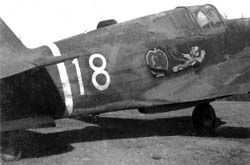 Dick Rossi’s P-40 Dick Rossi’s P-40 |
Which would have made you an ace even sooner?
I didn’t get the credit, but the biggest thing about combat was when you gotback, you were glad you made it. Flying combat can get pretty exhausting. Youdon’t know whether you’re upside down or right side up half the time ’causeyou’re chasing somebody. While you’re busy you don’t the difference but I’vecome back from missions and got out of the cockpit and had my knees buckle underme. I always had kind of a sinus problem anyway, and one day I dived down about10,000 feet to get away from a guy and then when I pulled out everything justwent black. I couldn’t see anything. But then it clears right away just as soonas you take the G load off, you’re clear again. One good thing we had on themwas diving speed, even though we didn’t know it at the time. If we’d known atthe time, we wouldn’t have to dive so much because airplanes can only go so fastwithout popping rivets, or at a certain speed their controls wouldn’t move. Wedidn’t find all that out until they captured some planes and did some tests.
I met a Japanese pilot after the war. When the Japanese got to pilots theydidn’t necessarily get a promotion. If the guy was a private, he stayed aprivate, he was still a pilot but he was a private, and they never gotpromotions. He said after they captured Hancow and they had time off they had togo out and cut the grass on the field and sometimes they were cutting grass allday. Well, with the B-25s we got these anti-personnel bombs that explode rightabove the ground, and just shear everything with shrapnel. He said wheneverthose would come over, they’d be in the trench hollering, ‘Hooray, hooray,”cause then they didn’t have to cut the grass.
How did you train in the single-seat P-40?
The first time I sat there for a few hours, just trying to see where allswitches were. You want to be able to do everything with your eyes closed, makesure you can feel for anything you want to, know where your gun switches are.Then I went up to around 10,000 feet and did everything I could with it, upsidedown, right side up, inverted spins. Inverted spins became kind of a problem.Once a guy got into an inverted spin when I was still in Pensacola and waskilled, so the Navy sent down a whole bunch of guys from Washington. Everybodyhad to go through inverted spins and then you had to take all your cadetsthrough them because it was just essentially the opposite of a normal spin, andyou did just the opposite of what you do on a normal spin. Instead of trying toget the thing to go down, you do just the opposite, and then that puts you intoa regular spin, which you know how to get out of.
We were told that the way the World War I pilots discovered how to get out ofa spin — the regular one — was the guy was spinning in and he figured he’sgoing to get killed, so he said, ‘I’ll make it fast,’ and pushed over and thenhe’d come out of the spin. We would practice one spin turn, two spin turns,three spin turns.
How often did you have to belly it in?
Most of the landings were made with the gear down but they didn’t always staydown. Sometimes they’d start down and end up with one folded.
One time the old man [Chennault] got this idea that we ought to disperse fiveairplanes, because we didn’t want to take a chance on the Japs catching them onour field at night. We took off and a thunderstorm passed through and the windswitched 180 degrees. There was a little field only 10 minutes away — anL-shaped deal — and it kind of went into a big ravine off one end. The firstguy to land was John Dean. He was in my class from Pensacola. He’d been in theNavy and he always landed, firmly, you know, like a Navy guy. So he lands andtaxis over to the reventment. Heck, nobody else thought anything of it and theywere all following him. I started to follow him and I couldn’t stop, so when Igot to the end I turned on the L. About halfway through the turn one gear poppedoff, and the P-40 gear wasn’t very strong for side loads, so I ended up there onmy stomach. Then I look out the side and I saw Bill Bartling. He’d gone over theend and hit there and just his tail stuck out. All of us except Dean cracked up,just trying to save these airplanes from getting hurt. That really got the oldman upset.
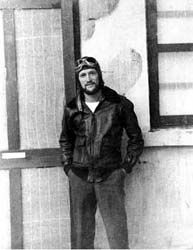 Kunming, 1942 Kunming, 1942 |
It takes you awhile to really feel at home in any new airplane, so if youhaven’t got a few hours in it, it always is a little bit strange, but by thetime we got out there the guys ahead of us had busted up so many that the oldman was really pretty ticked off. Guys were landing too long and not being ableto stop, so the old man put a chalk line across the runway — 200 feet down —and said, ‘Anybody that lands beyond that got fined 100 bucks. Tex Hill went toland and went into the drink. Old Pappy Boyington had put too much boost on andhe overshot and had to go around, and he went way past the boost on it and comearound and landed okay but was fined. The next guy that flew the airplane afterthe boost, it quit on him, so he had to put it down somewhere.
We could fix damn near any wreck if it didn’t break up; the ground crews werereally good. I had this one and we had a lot of trouble with the ignition on itsince they were fusing and then you lost all your spark. I was flying this planeand all of a sudden the thing just quit. All along the runways we had stacks ofdirt that were maybe four feet square and about a foot and a half high, so theycan make quick fills of the bomb craters as they happen while we’re out flying.I cut it a little too short and my damn right wheel caught that pile of dirtfull, and, of course ended up on the nose. Well, the Japs were too close. Wenever had time to rescue the ship — get it on the truck to have it sent up tobe fixed — so they just went out and took everything off of it that was anygood. Took all the guns out, took all the instruments out, any parts that wereusable, rudders, whatever, that they could make anything out of.
Were the planes in good shape when you took off for a mission?
Most of the time, except the radios. You might be able to hear and nottransmit or vice versa. I took off one day we got a late start and I was goingup flying on the wing of a guy named Ed Leibolt and we got up to 10,000 feet andhe motioned me in close and I, you know, come tucked into his, behind his wingthere. He just pointed to me and said, ‘You go up,’ and pointed to himself thathe’s going down, so I figured he forgot to put his oxygen on. We didn’t havedemand oxygen, we had steady flow, so the oxygen in the baggage compartment wasalways left open. Whenever you got an alert the first thing you were supposed todo was go open the oxygen valve and then get on board. We never ever saw himagain. It was a day before we left Rangoon for the last time, and I went outwith Charlie Bond and we searched and searched for a couple hours and never didsee any sign of him.
Did the Flying Tigers coordinate your missions with the RAF?
The British had the RDF, Radio Detection Finder, and that was our source ofwarning. If we were at Rangoon and we saw them take off, we just got in and tookoff, too. We didn’t know what was going on but we knew if they were taking offthere was some reason, and we used to run joint missions with them. Anytime wewanted to do anything on our own we didn’t have to ask them.
We got along real well with the Brits. They had one commander, Carey, who hadbeen to the Battle of Brittany, already had 21 victories, so he was our hero.Everybody looked up to him, and he was a real nice guy. As a matter of fact, acouple years ago I found out his address and I wrote him a letter to London, andhe showed me, he sent me back a postcard with a picture of kind of a, there wasa chapel, a church there, and he said whenever they got a mission and theweather was so bad they couldn’t find their field, it was almost always sunnynear this church. Once they got near that church, he’d know exactly how to getto their field.
What kind of guy was Chennault?
He was a very quiet, you know, soft-spoken southern gentleman. He was wellinto his 50s. He used to say that old deal, the door to my office is always openand any time you had problems, the old man would try to fix it for you. We had aguy went out there as a pilot and since I got there late, I didn’t know it untilten years later that he went out as a pilot. When two guys got killed training,he told the old man he didn’t want to fly, but he didn’t want to go home. He’dlike a ground job, and the old man gave him a ground job as operations clerk.Kirk Smith, the Marine that was in charge of the ship I was on, got into onecombat and they said he ran away and then he told the old man he didn’t want tofly and he gave him a job as adjutant or some sort of office work. Whatever youdid the old man would find some excuse for it.
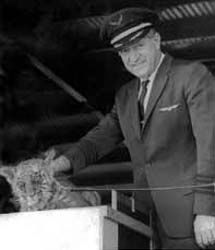 Capt. Rossi, 1969 Capt. Rossi, 1969 |
One thing about it that made some of the U.S. brass a little teed off waseverybody got out of the service, everybody’s civilian, nobody salutes anybody,except the old man. When the old man came around we’d stand up to talk to him,where it was feasible, and we always called him the old man but not in anyderogatory way. It was kind of an endearing term, really, and I never heard himraise his voice one time.
How about Boyington?
He was a good guy. No better, no worse than the rest of us.
Tell us about flying the hump for CNAC.
It was about 500-and-some-odd miles, and sometimes with the wind you getacross there you got there pretty fast. Then going back, you sort of stayed low,depending on the weather, you could be out of the jet stream and get back prettygood. But at that time we were getting paid by the hour so a lot of guys didn’tbother to go down below. We mostly flew from Din Jan to Quan Ming. We hadoccasional flights to other places. I flew a few trips in C-46s up to Hou Mi andHirumpshi, which were up near the Russian border, and I’d be taking Russiandiplomats or high-ranking people up that far and they would have somebody comedown and pick them up.
How did the Flying Tiger Line get started?
FTL is the only airline that began during the war. [FTL President Bob]Prescott had sixteen Budd Conestogas that were stainless steel. Budd’s thecompany that make train parts. We had some surplus C-46s and -47s, and someDC-4s. Then we got sixteen Connies; 1049-G Super Constellations. We looked atthe 1649s but didn’t get them.
We got some Canadair CL-44s — with the swing tail. They had a slow responseand were hard to land. But we could haul just about anything. We hauled F-104sfor the German Air Force by taking the wings off and sliding them in.
Which was your favorite?
The 1049 Super Connie. It was a great-handling airplane. You could reversetwo engines — which was the emergency descent procedure — and get down realfast. I also liked the stretch DC-8. All the controls had a cable backup, incase you lost pressure.
Did you fly any smaller planes in general aviation?
I had a Vultee Vibrator that I liked to fly.
Are you still flying?
Only in the back.
I know from your schedule that you’re still a moving target, travellingfrom one airshow to another. How often do you get to see the other AVG pilots?
There’s more interest now in WWII and we seem to be more visible as the yearsgo by. The AVG stays busy with all the requests to appear at functions, like airshows, and to be interviewed for people writing about us…like you!
Our AVG members are a tight-knit family. We get together at least once ortwice a year and we stay in constant contact. We were recently inducted into theNational Aviation Hall of Fame atDayton, Ohio, and also at the ConfederateAir Force Hall of Fame at Midland Texas. The AVG members are all over 80years old now and the 51 of us remaining are enjoying the honors that have comeour way.


































